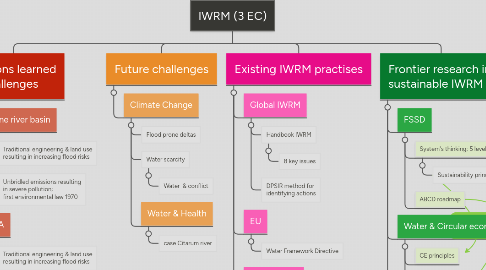
1. Lessons learned & challenges
1.1. Rhine river basin
1.1.1. Traditional engineering & land use resulting in increasing flood risks
1.1.2. Unbridled emissions resulting in severe pollution; first environmental law 1970
1.2. USA
1.2.1. Traditional engineering & land use resulting in increasing flood risks
1.2.2. Eutrophication of Gulf of Mexico; "dead zone"
1.3. China
1.3.1. Big dams to prevent floods
1.3.2. Connecting river basins (Yangtze-Yellow)
1.3.3. Unbridled emissions resulting in severe pollution
2. Future challenges
2.1. Climate Change
2.1.1. Flood prone deltas
2.1.2. Water scarcity
2.1.2.1. Water & conflict
2.1.3. Water & Health
2.1.3.1. case Citarum river
3. Existing IWRM practises
3.1. Global IWRM
3.1.1. Handbook IWRM
3.1.1.1. 8 key issues
3.1.2. DPSIR method for identifying actions
3.2. EU
3.2.1. Water Framework Directive
3.3. Netherlands
3.3.1. Room for the river
3.3.2. Deltaprogram
4. Frontier research in sustainable IWRM
4.1. FSSD
4.1.1. System's thinking; 5 level framework
4.1.1.1. Sustainability principles
4.1.2. ABCD roadmap
4.2. Water & Circular economy
4.2.1. CE principles
4.2.2. Application of the CE in the water sector through LLabs
4.3. Living Labs
4.3.1. Quadruple helix applied to local/regional communities
4.3.1.1. Cleantech & Smart Engineering
4.3.1.1.1. Flood adaptation
4.3.1.1.2. Energy & nutrient retrieval
4.3.1.1.3. Water scarcity
4.3.1.2. Innovative governance
4.3.1.2.1. Co-creation stakeholders (serious gaming)
4.3.1.2.2. Citizens science
4.3.1.3. New Business & financing
4.3.1.3.1. Valorisation of ecosystem services (e.g. biomass, IMTA, Paludiculture, LNG, Struvite)
